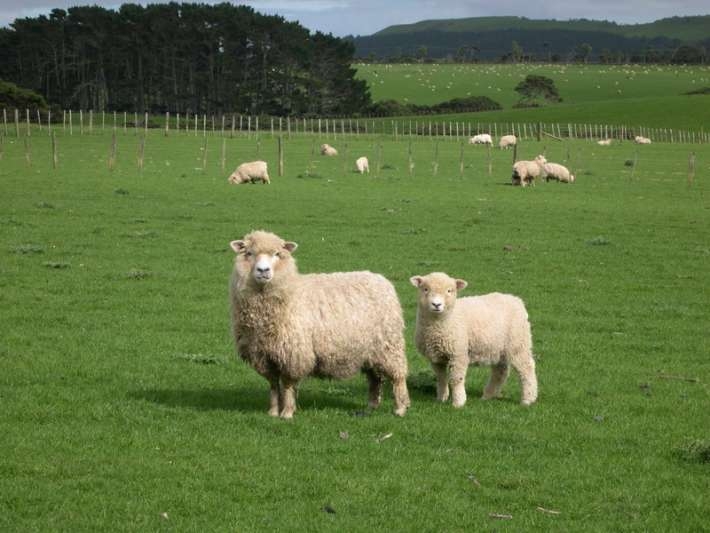
In the history of the sheep industry in NZ the romney has been the dominant breed from which many of the crossbreeds have evolved.
Now it appears from this article, they are making a strong comeback helped by targeted breeding schemes and focusing on productive practical gene evaluation.
As has been done in the dairy industry restricting the use of sires to only the very top animals, brings faster genetic gain and a quicker progression to more productive animals.
Weaning percentages of 180-190%, heavy off the mother first drafts, yielding 53%, and low death rates due to big birth weights, shows these Romney breeders have made impressive progress.
The workhorse in the sheep industry is still a productive ewe, Lincoln University-based agricultural scientist and lecturer Dr Jon Hickford says in the ODT. It was the ewe that underpinned the productivity and Dr Hickford believed that the emphasis had come off the performance overall of the ewe. "I think we've lost sight of the importance of an efficient lamb-bearing system," he said. He has been involved with Romney New Zealand's Merial saleable meat yield trial, which has been running since 2006.
The project was primarily to show the performance figures of the Romney ewes in the trial and try to improve the meat yield of the lamb carcass and it had achieved both, he said. At the beginning of the trial, stud breeders throughout New Zealand were encouraged to put forward their best meat-yielding ram and 15 rams were then each put to 60 ewes. Two seasons ago, a lambing weaned percentage of 165% was achieved, with the first draft killing out at 18.7kg at 13 weeks with a meat yield of 53%, and 66% went off their mothers. There were two more drafts and all the lambs still killed at 53%.
This last season, only seven of the higher end of the rams performing for meat yield were used. There was a weaning percentage of 185%, with only 6% of lambs lost at birth and 4% between birth and weaning. Sixty-six percent of lambs again went off their mothers at 18.5kg, yielding 53.5%. Hugh Taylor, from Romney New Zealand, said ewes producing lambs with more than 52% yield had been identified and top-performing rams put over them. Some of the elite ram lambs, from the high-performing ewes, would then be put back over those ewes.
Dr Hickford said robust, easy-care sheep had been a hallmark of the New Zealand Romney and the crossbred ewe was as valuable today as 100 years ago. The Romney ewe was showing up to be a robust lamb producer and he detected that realisation was occurring across the country's sheep industry. In the last three years of the trial, the number of lambs hitting the ground had gone from 162% to 195%, which was "remarkable" and not what people expected of Romneys.
In 2008, 12.7% of lambs died before weaning, a figure that was quite low. But in 2010, only 5.1% were lost and, during that time, there were two snow events. Dr Hickford was impressed with the ewes' mothering ability - "they look after their lambs" - saying they were remarkably efficient. The average lamb birth-rate was nearly 6kg. Twin bearing ewes could carry nearly 12kg of lambs, sustain those pregnancies and then lamb, with very few lambs dying. At those weights, the lambs were "on the front foot" in terms of pre-weaning growth, which again showed the ewe efficiency, he said.
Romneys were fast growers, which were crucial for dry hill country systems. If lambs did not survive or grow at a reasonable pace through to weaning, then it was not productive. In hard, hill country lambing, where farmers could not control the weather or feed supplies, good robust ewe systems were needed. The Romney could do that and have a high yielding lamb, he said. The meat yield figures were "money for jam" for meatworks - getting 3% to 4% more lean meat on the carcass - and he believed Romneys were "right up there", if not better.
4 Comments
A good example of how the genetics available to us are now far superior to the ones available even 10 years ago. All achieved without GM technology to boot!
This is one of the reasons agricultural productivity growth has outpaced that in the general economy. Whilst sheep are the subject of this article the same is true of dairy,grain and grasseed yields etc. Unfortunately until recently we have needed to run faster to stand still. However if you factor in a riseing commodity price trend into the mix , good farmers should flourish.
And we will know this to be true because the country's level of agricultural debt will be coming down.
Good to see the romney getting some recognition, I swear by them they are an outstanding breed.
Good to see the romney getting some recognition, I swear by them they are an outstanding breed.
We welcome your comments below. If you are not already registered, please register to comment.
Remember we welcome robust, respectful and insightful debate. We don't welcome abusive or defamatory comments and will de-register those repeatedly making such comments. Our current comment policy is here.